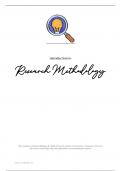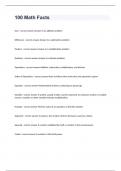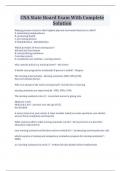Research Methodology
This summary is based on Morling, B. (2020). Research methods in Psychology: Evaluating a World of
Information, knowledge clips and explanations received during the tutorials
Laura C./ Tilburg/ ‘22
,Ch. 1 Psychology is a way of thinking
• psychologists are empiricists; they base their conclusions on systemic, unbiased
observations of the world
• using the theory-data cycle, researchers propose theories, make
hypothesis(predictions) and collect data; a good scientific theory is supported by data
and is falsifiable.
• researchers do not claim that theories are not proven but they can say that a theory is /
is not well supported or well established (meaning that most of the data confirmed the
theory and very little data have disconfirmed it)
• there are 3 types of researchers/ research:
o applied research- address real-world problems
Laura C./ Tilburg/ ‘22
, o basic research- its goal is to enhance the general body of knowledge, without
regard for direct application to practical problems
o translational research- uses knowledge derived from basic research to
develop and test solutions to real-world problems
• scientists strive to follow the 4 norms (shared expectations about how they should
act) of the scientific community (Merton's norms):
o universalism- scientific claims are evaluated according to their merit,
independent of the researcher’s credentials or reputation. The same
preestablished criteria apply to all scientists and all research
o communality- scientific knowledge is created by a community, and its findings
belong to the community
o disinterestedness- scientists strive to discover the truth whatever it is; they are
not swayed by conviction, idealism, politics, or profit
o organised scepticism- scientists question everything, including their own
theories, widely accepted ideas, and “ancient wisdom”
• the publication process is part of the worldwide scientific communication; scientists
publish their research in journals
• before research is published, it must be subjected to the peer-review process; the
published work can be approved or criticised by the scientific community
• journalists who are writing for popular media outlets often 'translate' scientific studies
for the general public; however, they do not do so accurately and leave out many
details => when reading something online, it's best to think critically and if possible,
to go directly to the original source: peered-reviewed research
Laura C./ Tilburg/ ‘22
,Ch. 2 Sources of information
• people's beliefs can be based on the following:
their own experience
their intuition
authorities
controlled research
• research information is the most accurate source of knowledge
Research vs personal experience
• beliefs based on personal experience may not be accurate because they do not involve
a comparison group
• in research, 'compared to what? ' is an important question that needs to be answered;
therefore, researchers design studies that include comparison groups
• personal experience is often confounded- as many things are happening at once, it is
impossible to know which factor is responsible for a particular outcome; researchers,
however, can closely control for confounding factors
• confound- a general term for a potential alternative explanation for research finding
• conclusions based on research are probabilistic- research findings can't predict or
explain all cases all the time; the realistic aim is to be able to predict or explain a high
proportion of cases
Research vs intuition
• intuition is a poor source of information because it is affected by biases in thinking:
→ availability heuristic- people overestimate how often something happens if
they consider only readily available thoughts, those that come to mind most
easily
→ present/ present bias- people find it easier to notice what is present than what
is absent
→ confirmation bias- we seek out evidence that confirms our initial ideas and
fail to seek out evidence that can disconfirm them
→ bias blind spot- we believe that we are less biased than everyone else
• scientific researchers are aware of these biases and use comparison groups, consider
all data, and allow the data to change their beliefs in order to reduce as much as
possible the influence of biases on their thinking
Trusting authorities
• an authority in a field should not be believed when they base their claims on intuition
or personal experience; their claims/ advice and lessons are worth taking into
consideration only when they are based on well-conducted studies
• disinformation- news that is deliberately created and spread to mislead or provoke
Laura C./ Tilburg/ ‘22
, Sources of information:
Finding and reading the research
• journal articles:
→ empirical journal articles- a scholarly article that reports for the first time the
results of a research study.
→ review journal articles- an article summarizing all the studies that have been
published in one research area (review articles sometimes use meta-analysis- a
way of mathematically averaging the effect sizes of all the studies that have
tested the same variables to see what conclusion that whole body of evidence
supports
→ to make sure of the quality of the journals, we can use Cabell's blacklist of
predatory journals
• books and edited books (books that contain chapters on a common topic written by
different contributors)
• PsycINFO
• Google Scholar
Components of an empirical journal article:
• abstract
Laura C./ Tilburg/ ‘22
, • introduction
• method
• results
• discussion
• references
Laura C./ Tilburg/ ‘22
,Ch. 3 3 claims, 4 validities
• the 3 claims- 4 validities framework helps us to evaluate any study we read and set
guidelines for studies that researchers design
Variables
• a variable: an attribute that varies, having at least two levels, or values
vs.
• a constant: an attribute that could potentially vary but that has only one level in the
study in question
• there are two types of variables:
→ measured variable- a variable in a study whose levels (values) are observed
and recorded
→ manipulated variable- a variable a researcher controls (! some variables cannot
be manipulated- e.g., age, IQ or it is unethical to do so)
• variables can be described in two ways:
conceptual variables (constructs)- variable of interest, stated at an abstract, or
conversational, level
operational variables (operationalizations)- a specific way in which a concept of
interest is measured or manipulated as a variable in a study
• operationalization/ operational definition- how the construct is measured or
manipulated in an actual study
Three claims
• frequency claims
• association claims
• causal claims
claim type definition example
Frequency make arguments about the level of a 39% of teens
claims single, measured variable in a group admit to texting
of people while driving
Association argue that two variables are related to Girls more
claims each other; likely to be
an association can be positive, compulsive
negative or zero (depicted on texters
scatterplots); Countries with
when two variables are associated, more butter
we can use one to predict the other have happier
citizens
verbs phrases used: is linked to, is
associated to, is correlated with, may
predict, is tied to, goes with, is
more/less likely to
Laura C./ Tilburg/ ‘22
, Causal state that one variable (independent Family meals
claims variable) is responsible for changes in curb eating
the other variable (dependent disorders
variable) Pretending to
be Batman
verbs phrases used: causes, affects, helps children
changes, may lead to, hurts, stay on task
promotes, prevents, distracts,
increases, trims, adds, fights, reduces
The four big validities
type of description
validity
Construct How well the variables in a study are measured or manipulated.
validity
External The extent to which the results of a study generalize to some
validity larger population (e.g., whether the results from this sample of
teenagers apply to all U.S. teens), as well as to other times or
situations.
Statistical How well the numbers support the claim—that is, how strong
validity the effect is and the precision of the estimate (the confidence
interval). Also considers whether the study has been replicated.
Internal In a relationship between one variable (A) and another (B),
validity the extent to which A, rather than some other variable (C), is
responsible for changes in B.
Interrogating the 3 claims using the four big validities
frequency association causal claim
claim claim
construct x x x
validity
external x x x
validity
statistical x x x
validity
internal x+
validity covariance
Laura C./ Tilburg/ ‘22
, temporal
precedence
• usually, researchers cannot achieve all four validities at one in one experiment, so
they prioritize them
Interrogating frequency claims
• to interrogate frequency claims, ask questions about:
construct validity (quality of the measure)
external validity (generalizability to a larger population)
statistical validity (the % estimate, its confidence interval, and other estimates of the
%)
[point estimate- a single estimate of some population value (usually as a percentage)
based on data from a sample]
[confidence interval/ margin of error of the estimate- an inferential statistic
providing a range of values that has a high probability of containing the true
population value]
Interrogating association claims
• to interrogate association claims, ask questions about:
construct validity (quality of the measure)
external validity (generalizability to a larger population)
statistical validity (addresses the strengths of the relationship and the precision with
which it is estimated)
Interrogating causal claims
• when interrogating a causal claim, we first need to make sure that the research fulfils
the three criteria for causation:
→ covariance
→ temporal precedence
→ internal validity
covariance- the extent to which two variables are observed to go together.
temporal presence- the causal variable clearly comes first in time, before the effect
variable
internal validity (third-variable criterion)- refers to the study's ability to eliminate
alternative explanations for the association
Laura C./ Tilburg/ ‘22
, Ch. 4 Ethical guidelines for psychology research
• regardless of the type of research conducted, all research must be conducted ethically
Historical examples of bad practices
• The Tuskegee Syphilis Study (USA, '30s-'70s); illustrates the ethical violations of
harming people, not asking for consent, and targeting a particular group of people
only.
• The Milgram obedience studies; depicts the grey areas in ethical research, including
how researchers define harm to participants and how they balance the importance of a
study with the harm it might do
Ethical core principles
• the Nuremberg Code and the Declaration of Helsinki govern many countries' ethical
policies when it comes to research
• In the USA, ethical policies are based on the Common Rule which is grounded in the
Belmont Report
• the Belmont Report outlines 3 main principles for research:
o respect for persons (involves the process of informed consent and the
protection of special groups in research (such as children and prisoners)
o beneficence (involves the evaluation of risks and benefits to participants in
the study and to society as a whole)
o justice (involves the way participants are selected for research; one group
of people should not bear the undue burden for research participation, and
participants should be representative of the groups that will also benefit
from the research
Guidelines for psychologists: the APA ethical principles
• the APA provides psychologists (in all professional roles) with a set of principles and
standards for research, teaching, etc.
• the APA's five general principles include the 3 Belmont Report principles plus other
two: the principle of fidelity and responsibility and the principle of integrity.
• the APA's Ethical Standard 8 provides enforceable guidelines for researchers to
follow; it includes information for:
informed consent
institutional review boards
deception [the withholding of some details of a study from participants (deception through
omission) or the act of actively lying to them (deception through commission)]
debriefing (to inform participants afterwards about a study’s true nature, details, and
hypotheses)
research misconduct
animal research
Laura C./ Tilburg/ ‘22




